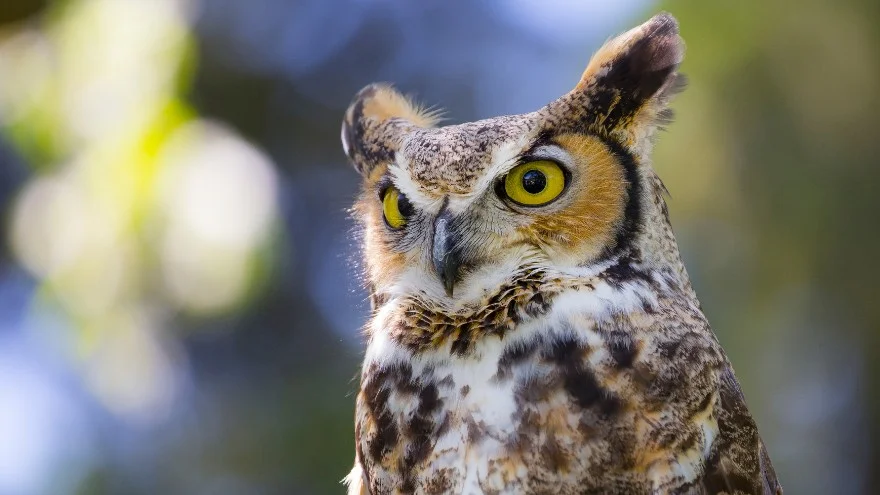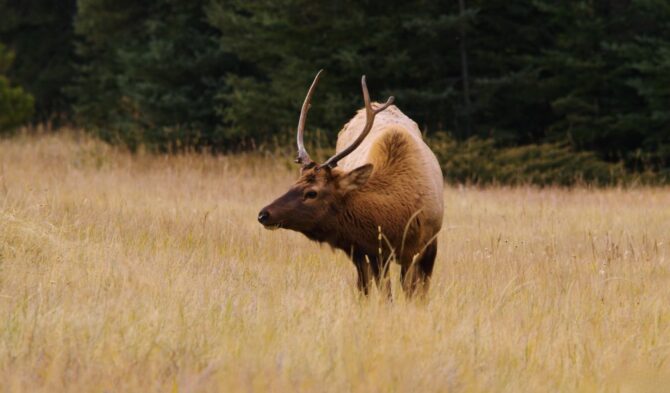Owls are known for their chilling cynical stares and ability to turn their heads around to a whopping 270 degrees.
Coupled with their love for dark places and hooting, they have earned a reputation for strange and frightening vibes.
These birds from the Strigiforme order possess capabilities that make it possible for them to adapt to almost every ecosystem on the planet.
Owls are predators with incredible hunting capabilities and soundless flights. These birds are located in different places. In the United States, North Carolina is one state where owls abound.
The different species of owls in North Carolina include the barred owl, great horned owl, barn owl, short-eared owl, northern saw-whet owl, eastern screech-owl, and snowy owl, among others. These species inhabit different habitats such as forests, marshes, and woodlands.
This article will discuss extensively ten species of owls you can find in North Carolina.
Species of Owls in North Carolina
1. Barred Owl
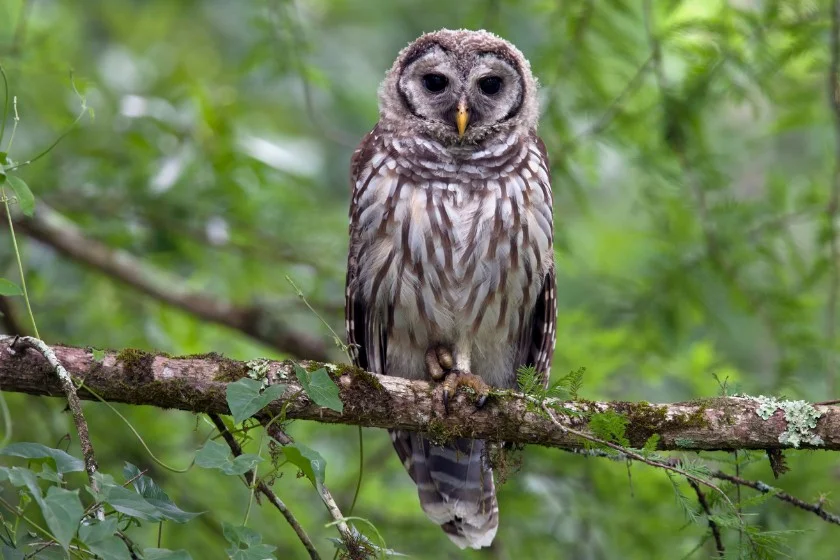
- Size: 40–63cm (length), 96–125cm (wingspan), 479g–1.2kg (weight)
- Colors: Grey-brown, dull brown
- Physical Features: Round head, yellow eyes, dark stripes
- Habitat: Woodlands, wooded swamps, wooded river bottom
- Scientific name: Strix varia
The barred owl, the striped owl, or the hoot owl, is found in North America. It is a large owl and a member of the true owl family.
They are native to the eastern part of North America and invasive to North America’s West coast.
They are nocturnal birds, preferring to sleep all day. They are fond of making abandoned nests of other birds their home.
Among the true owl family members in the United States, the barred owls are the only members with dark eyes.
They have dull colors and look graceful in the air with occasional long glides. They have a unique hooting with varied calls.
When you are in North Carolina and hear a rhythmic call sounding something like “who cooks for you, who cooks for you all,” know that the barred owl is nearby.
2. Great Horned Owl
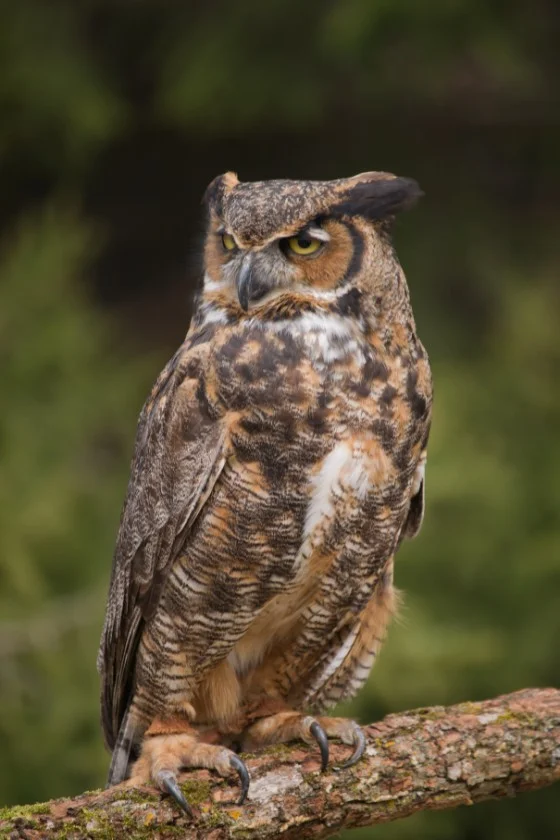
- Size: 43–63cm (length), 145cm (wingspan), 1.6kg for males, 1.2kg for females(weight)
- Colors: Dark brown, light bluff
- Physical Features: Large, thick, feathered tuft
- Habitat: Forests, mountains, woodlands
- Scientific name: Bubi virginianus
The great horned owl is also called the tiger owl. It is the only member of the true owl that is widely distributed in America due to being able to adapt easily to a wide range of habitats.
They have hair tufts that look like horns hence the name great horned owl. Their brownish color aids them in camouflaging.
Apart from the northern population of the great horned owl, the rest are comfortable in temperate regions all year round and do not migrate.
They can live in suburban areas as well as densely wooded regions. They have remarkable hearing capabilities and make the ho-ho-ho hoo hoot that sounds like you still up? Me too.
3. Barn Owl
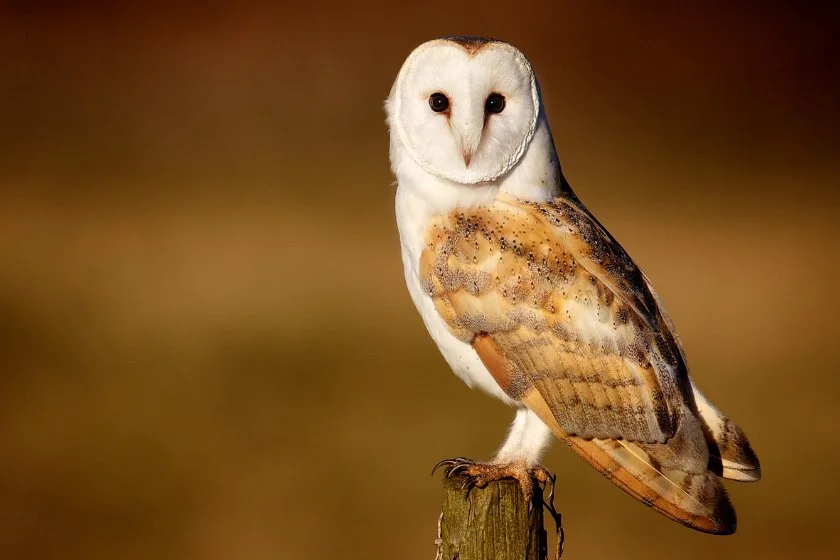
- Size: 35–50cm (length), 68–105cm (wingspan), 220–710g (weight)
- Colors: Pale brown, grey, white
- Habitat: Woodlands, church belfries, barns, tree holes
- Physical Features: White heart-shaped face, spotty
- Scientific name: Tyto alba
The barn owl is prevalent worldwide and abundant in North Carolina. It is also known as the common barn owl and is nocturnal for most of its range.
They can also hunt during the day and prey on small mammals, which they sense using sound, as their sense of hearing is very acute.1
They are renowned for their soundless flight; their wings make absolutely no sound in the air, and their pale bodies give the impression of ghosts, consequently earning them the name ghost owls.
They produce long resonating shrieks that are discomforting to the human ears. Just like snakes, they produce a hiss when they feel threatened.
4. Short Eared Owl
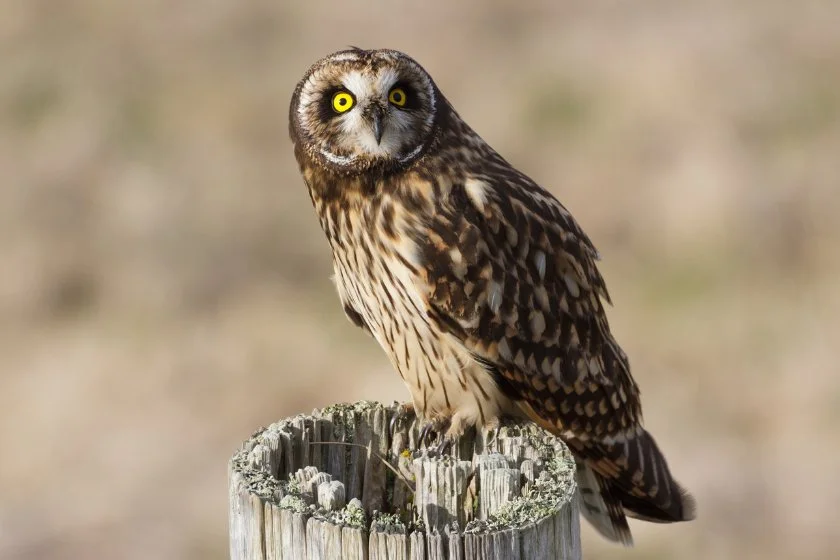
- Size: 34–43cm, 85–110cm wingspan, and 206–475g weight.
- Colors: Medium Brown
- Physical Features: Yellow-orange eyes, dark rings encircling its eyes,
- Habitat: Marshes, prairies, dunes
- Scientific name: Asio flammeus
The short-eared owl can be found on all continents apart from Antarctica and Australia. They are one of the most distributed bird species in North Carolina.
They have medium brown bodies which are spotted buff and are white on the upper side. Their faces are pale, their eyes are yellow and there are dark rings surrounding the eyes. This gives them a mascara look.
When hunting, they fly low, lingering over for a while before advancing toward their prey.
These owls prey on rodents, amphibians, fish, and small birds. They have a scratchy bark-like call with sounds like waaowk,waaowk, waaowk, or hoo hoo hoo being common.
5. Northern Saw Whet Owl
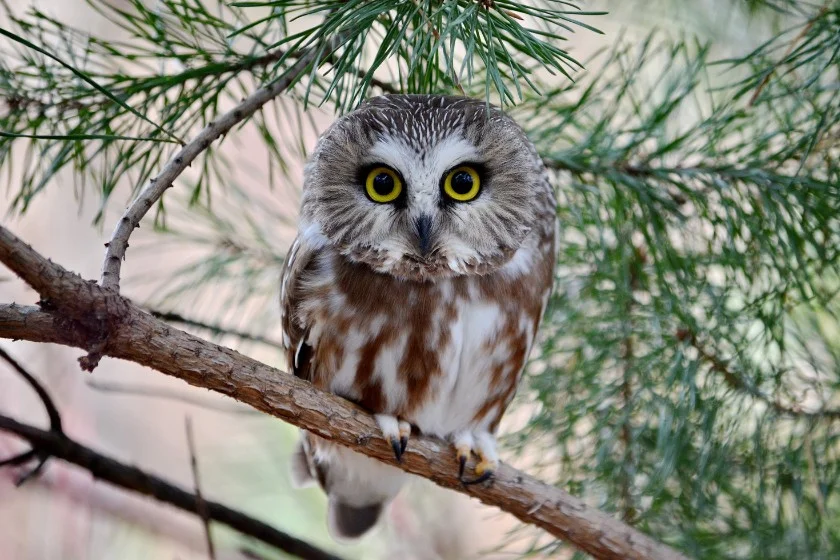
- Size: 17–22cm length, 42–56cm (wingspan), 54–151g (weight)
- Colors: Mottled brown
- Physical Features: Mottled brown bodies, yellow eyes,
- Habitat: Coniferous forests, Tree cavities, abandoned nests
- Scientific name: Aegolius
In terms of size, the Northern saw-whet owl is among the smallest members of the true owl family in North Carolina.
As much as they are predators, they occasionally end up as prey for larger birds. They have yellowish eyes and dark bills bent downwards.
They do not have ear tufts. Between their eyes lies a Y-shaped distinct coloration. They have strong hearing which enables them to hunt in complete darkness using hearing alone.
The sound made by this owl has been likened to a saw being sharpened by a whetstone.
6. Eastern Screech Owl

- Size: 16–25cm (length), 166g in males, 194g in females(weight), 46–61cm
- Colors: Grey morph, rufous morph
- Physical Features: Round head,yellow eyes, yellow beak, broad-winged
- Habitat: Forests, suburbs, woodlands
- Scientific name: Megascops asio
Eastern screech owls are small-sized owls native to North America. They are one of the owls that inhabit North Carolina.
Due to their nocturnal habits, they can be hard to spot at times, In as much as they adapt well to artificial environments.
They have large heads and are typically feathered down to the toes. They are among the heaviest screech owls.
They are strictly nocturnal and prefer to roost during the day. Although they adapt in residential areas, there is more likelihood of hearing them than seeing them.
They do not make screech despite having screech to their name. The call of this bird is a tremolo, likened to that of a miniature horse.
7. Snowy Owl
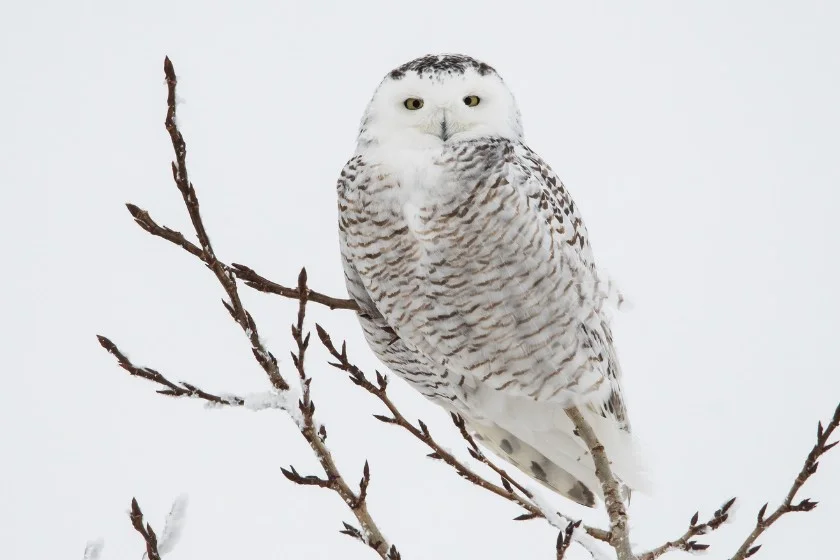
- Size: 52.5–64cm for males, 54–71cm for females (length), 116–165.6cm for males, 146–183cm for females (wingspan), 1465–1808g for males, 1706.7–2426g for females (weight)
- Colors: White
- Physical Features: Small head, bright yellow eyes,
- Habitat: Coastal dunes, prairies, meadows, island
- Scientific name: Bubo scandiacus
Across the Carolinas, the snow owl is found where temperatures suit young species.
Males are completely white and have few spots on their wings which tend to fade as they grow old. Females, on the other hand, have conspicuous spots on their wings and backs.
They prefer snowy regions, flying low, and sitting near the ground. Also, they like being near lakes when they are hunting for food.
They typically prey on insects, hares, small seabirds, and ducks. They hunt at night as well as during the day.
8. Burrowing Owl
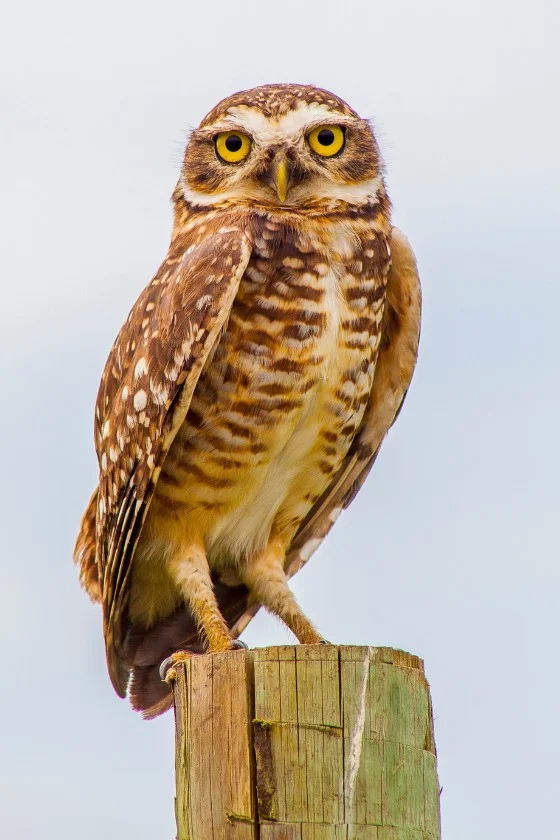
- Size: 19–20cm (length), 50.8–61cm(wingspan), 140–240g(weight)
- Colors: Mottled brown
- Physical Features: Bright eyes, white eyebrows, legs without feathers
- Habitat: Open grasslands, prairies, farmlands
- Scientific name: Athene cunicularia
Unlike many owl species, burrowing owls are not nocturnal birds. They are highly active during the day and are small in size with no feather coverings on their long thin legs. They have no ear tufts on their smooth heads.
Adults are brown-colored, mottled with sandy-pale spots on their upper parts. Their breasts are spotted, too, and they have dark brown bars on their bellies.
Like snow owls, they love to fly low and spend most of their time on the ground. They prey on insects and small mammals. They can live for up to 9 years in the wild and 10 years in captivity.
9. Long-Eared Owl

- Size: 31–40cm (length), 288g for males, 327g for females (weight), 86–102cm (wingspan)
- Colors: Hues of Tawny
- Physical Features: Yellow eyes, yellow facial disk
- Habitat: Forests, woodlands, pastureland, parks, cemeteries
- Scientific name: Asio otus
The long eared owl is a medium-sized bird known as the lesser horned owl or the cat owl.
This specie of owl breeds in many areas in North Carolina. It prefers nesting and roosting within dense wood stands but hunts over open grounds.
This bird is a specialized predator whose diet mostly consists of insects.
The prey population determines the breeding success of this specie of bird. These owls are not considered territorial.
Females have smaller syrinx than males; consequently, their voices are less powerful than the males, and they make weaker calls which are likened to tin whistles.
10. Boreal Owl
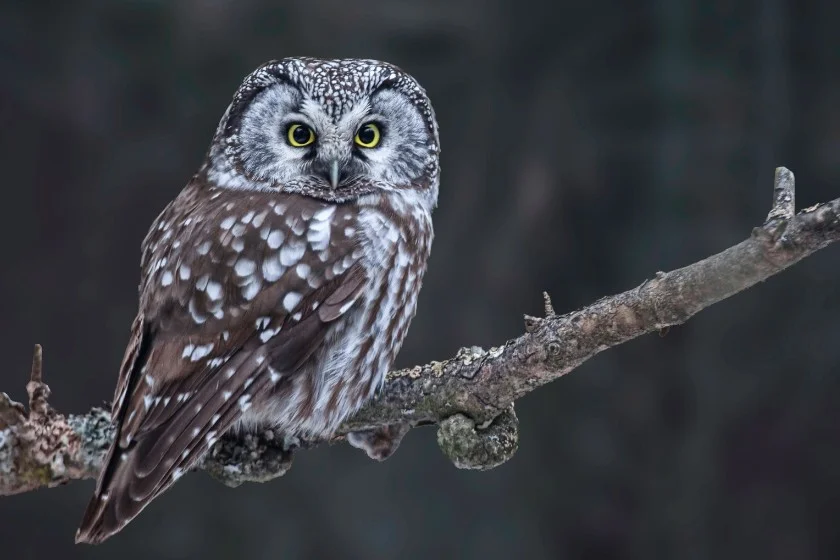
- Size: 22–27cm (length), 50–60cm (wingspan), 131–179g for females, an average of 107g for males(weight)
- Colors: Brown
- Physical Features: Large head, yellow eyes
- Habitat: Coniferous forests, mountains
- Scientific name: Aegolius Funereus
This small-sized owl belongs to the true owl family Strigidae. It has a large head and a white facial disc which often depicts the owl as having a surprised expression.
The male Boreal owl and the female look similar in appearance. They make straight and soundless flights.
The boreal owl’s diet mainly consists of voles and small mammals, but they also eat birds, insects, and other small invertebrates.
The Boreal owl is typically shy and avoids humans; they are nocturnal and prefer inaccessible forests. Consequently, they are rarely seen.
Conclusion
Different species of owls in North Carolina thrive in various habitats of different sizes in the state. Owls are not dangerous to humans. Therefore owl attacks on humans are hardly heard in the state.
They are harmless creatures unless you constitute a threat to them, especially by taking their young ones away.
If you are in North Carolina and you decide to jog through the woodlands or forests, you may come across these owls, but they will not attack you if you keep your distance.
Next up…
- 7 Owls In South Carolina (Species Identification & Pictures)
- 10 Most Dangerous Animals In North Carolina (Watch Out)
- Wildlife In America – Native Animals In The United States
References & Notes
- Kraemer A., Baxter C., Et. al. 2018. Development of Auditory Sensitivity in the Barn Owl. J Comp Physiol A Neuroethol Sens Neural Behav Physiol.
